The garden at Prospect Cottage, located in Kent on England’s east coast, was created by the late Derek Jarmon, a filmmaker, diarist and early advocate of gay rights. It is a garden that sits lightly on the land while simultaneously conveying a powerful sense of place. It is also one that elicits a strong response from visitors. Either they like it or they don’t, are intrigued by it or walk through quickly, dismissing what they see as a collection of rubbish with some flowers thrown in.
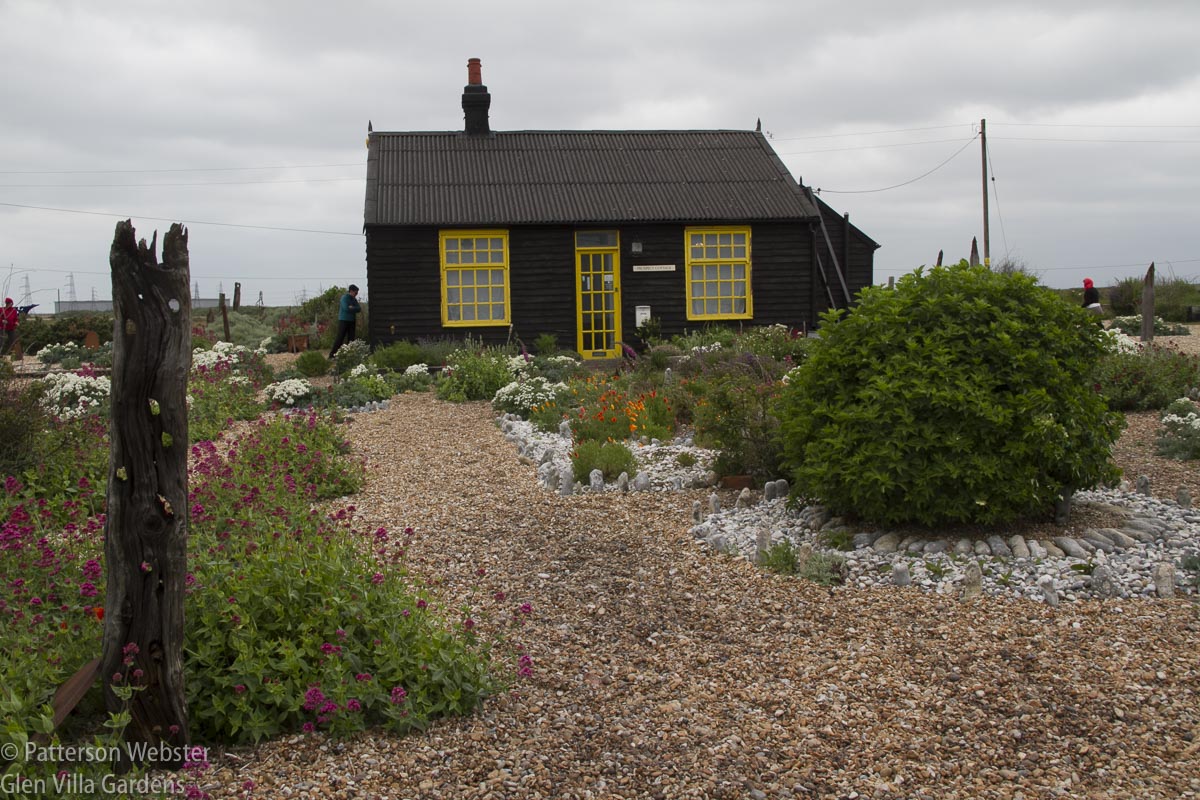
Set on a pebble beach in Kent, Prospect Cottage retains the simplicity of its origins as a fisherman’s cottage.
Jarman described the cottage in his collected journals, Modern Nature.
Prospect Cottage, its timbers black with pitch, stands on the shingle at Dungeness. Built eighty years ago at the sea’s edge—one stormy night many years ago waves roared up to the front door threatening to swallow it… Now the sea has retreated leaving bands of shingle. You can see these clearly from the air; they fan out from the lighthouse at the tip of the Ness like contours on a map.
It is certainly no ordinary garden. I visited the site earlier this year, on a cold and blustery day that felt more like November than the June day it was. Across the deserted shingle beach, the Dungeness Nuclear Power Plant squatted menacingly, grey building against grey sky.

The two power plants are located on the largest area of shingle beach in Europe, 12 kms by 6 kms. The beach was built up by sea action over thousands of years.
Yet despite the weather and the bleak setting, the garden felt alive. Behind the cottage next door, laundry flapped on a clothesline. Gulls circled and cawed. Flowers danced in the wind and caught fire in random bursts of sunlight.
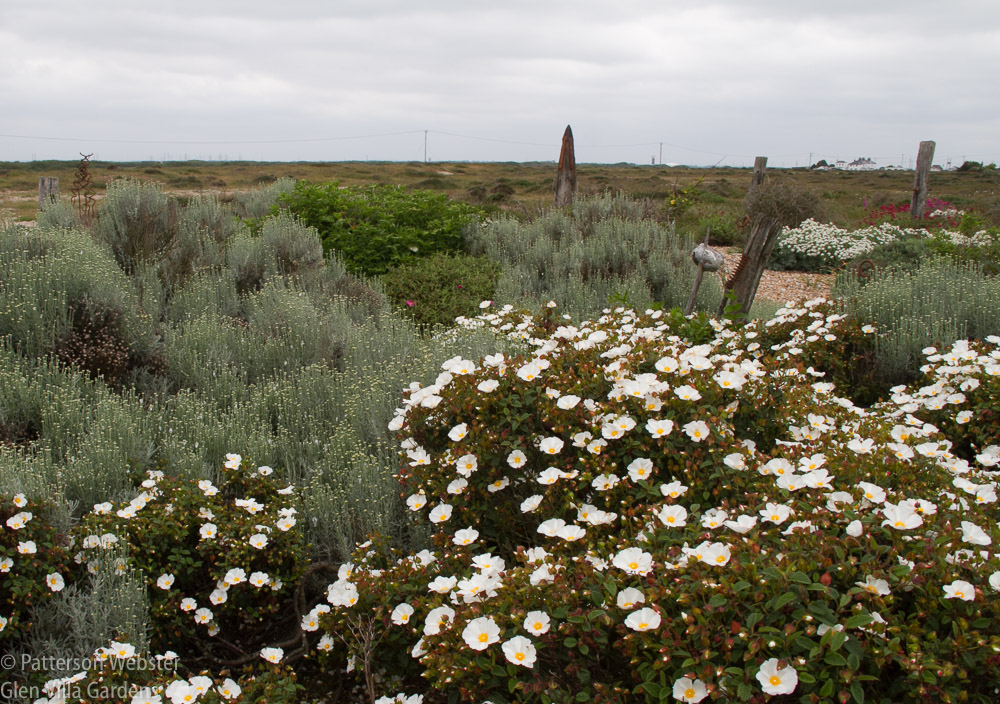
Mounds of flowers, blooming or about to bloom, grew on the shingle beach.
Flowers played a minor, albeit colourful, role in the garden. In front of the cottage their arrangement in stone-edged circles and rectangles gave a nod towards the shape of traditional flower beds, but elsewhere plants grew willy-nilly, wherever they could withstand the harsh maritime conditions.
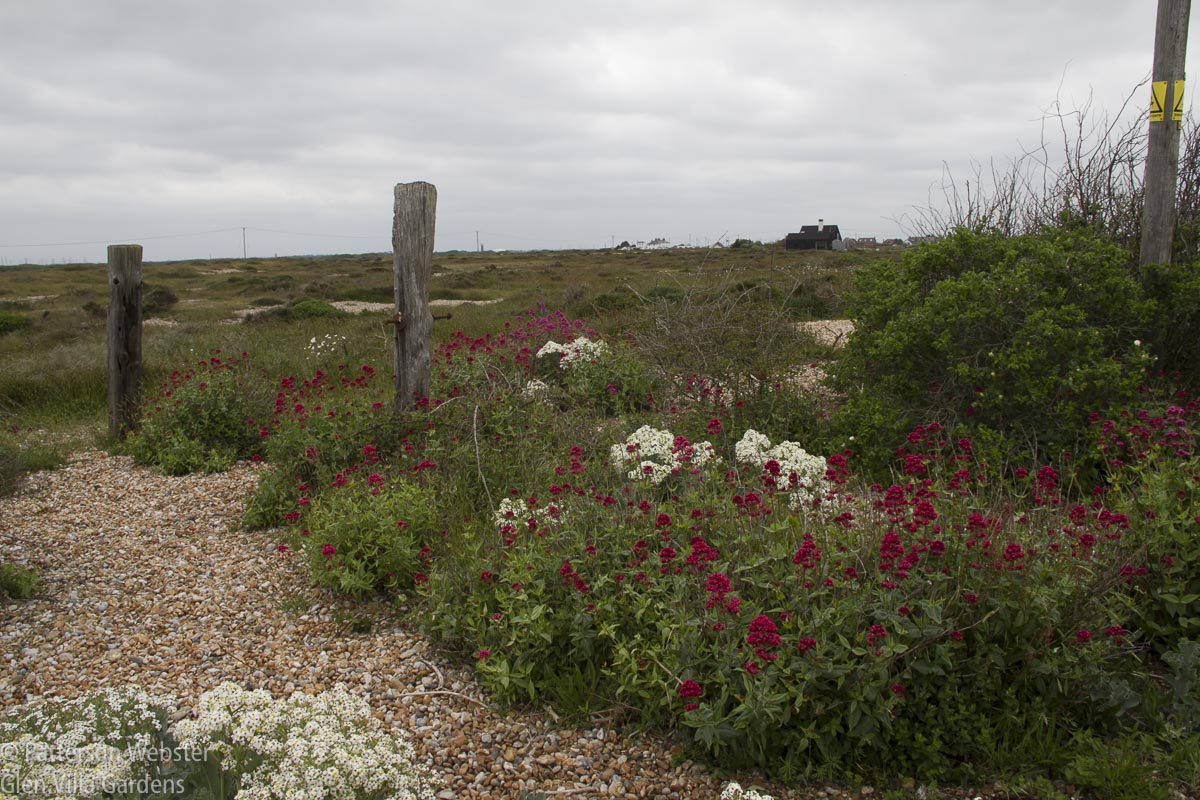
Although not evident in this photo, plants with silver-grey foliage predominated — santolina, lavender and crambe maritima in particular.
Objects found on the beach and repurposed as art were laid out casually around the house: a wooden boat, rusted chains, buoys, scraps of metal, rock-encrusted shells. Tall posts offered a place for birds to perch. And while every object seemed to be placed at random, together they created a powerful narrative.

This random collection of object suggested an altar. But an altar to what?
The narrative was slippery, though, hard to grasp, shifting as constantly as the shingle beach itself. From one point of view the story spoke of how beautiful loneliness can be, how suggestive of things beyond. Through this lens a miniature circle of rocks echoed larger circles made by Richard Long in response to the environment he walked through on his solitary long distance hikes.
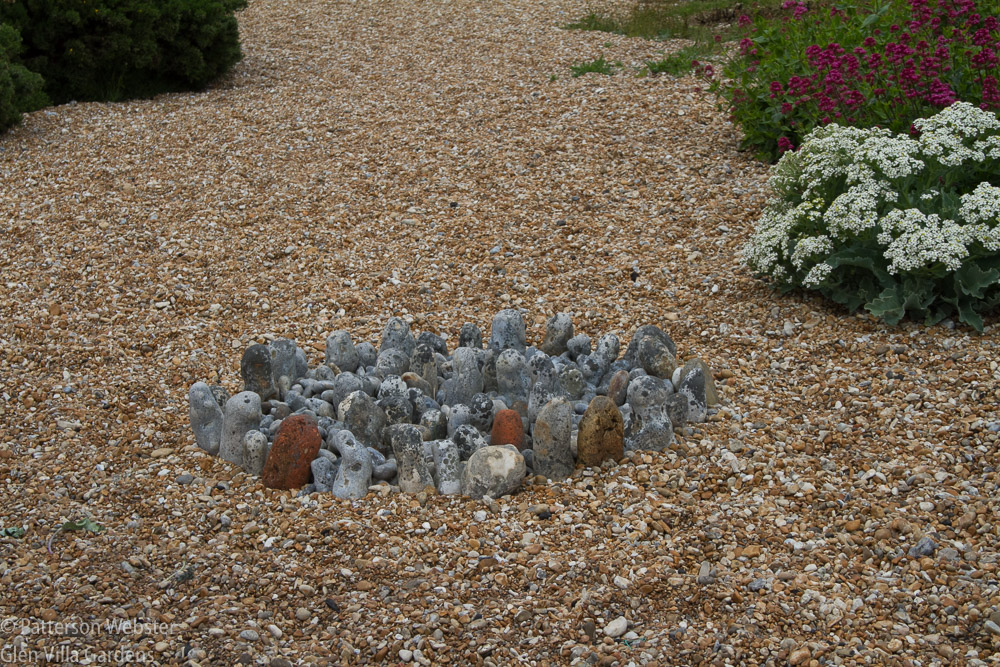
It’s perhaps because I’ve seen full-sized versions of stone circles by Richard Long in England and various locations in the U.S. that this small circle reminded me of them.
From another point of view the story was more poignant. Thanks to the chains piled nearby, a circle of smooth stones hanging on a pointed stake suggested a necklace on the throat of an unwillingly be-jewelled model. A triangle of metal protruding from stony ground suggested a sailboat sinking close to shore.
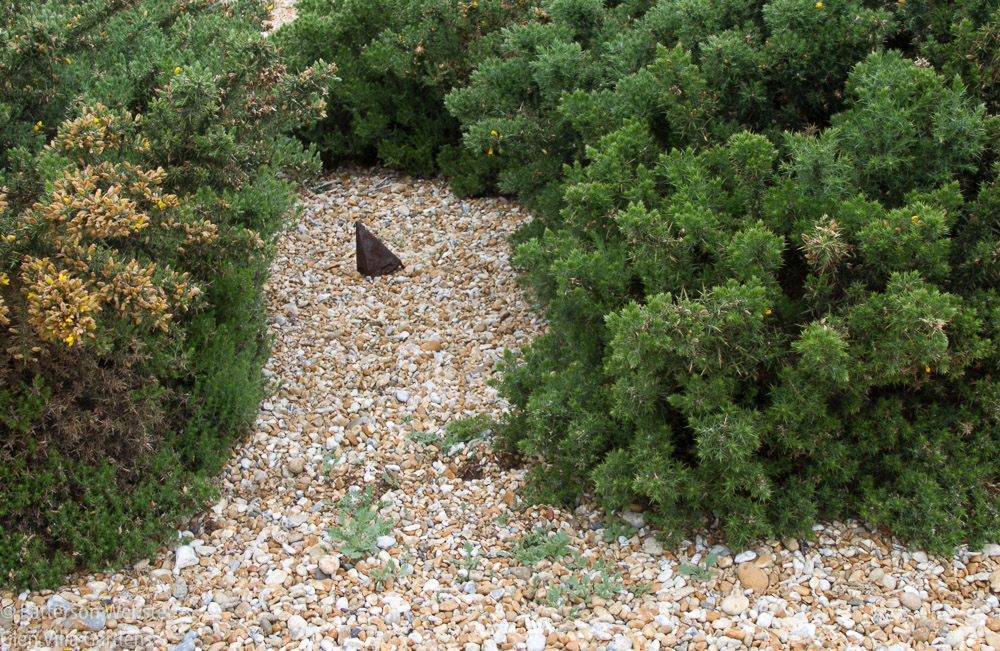
Do you feel the presence of the boat under ground or see a triangle of metal stuck into the rocks?
Not surprising for someone who was soon to die, the effects of time were vividly present — rusted metal, worn timbers, a tree trunk with holes carved by stones and waves.
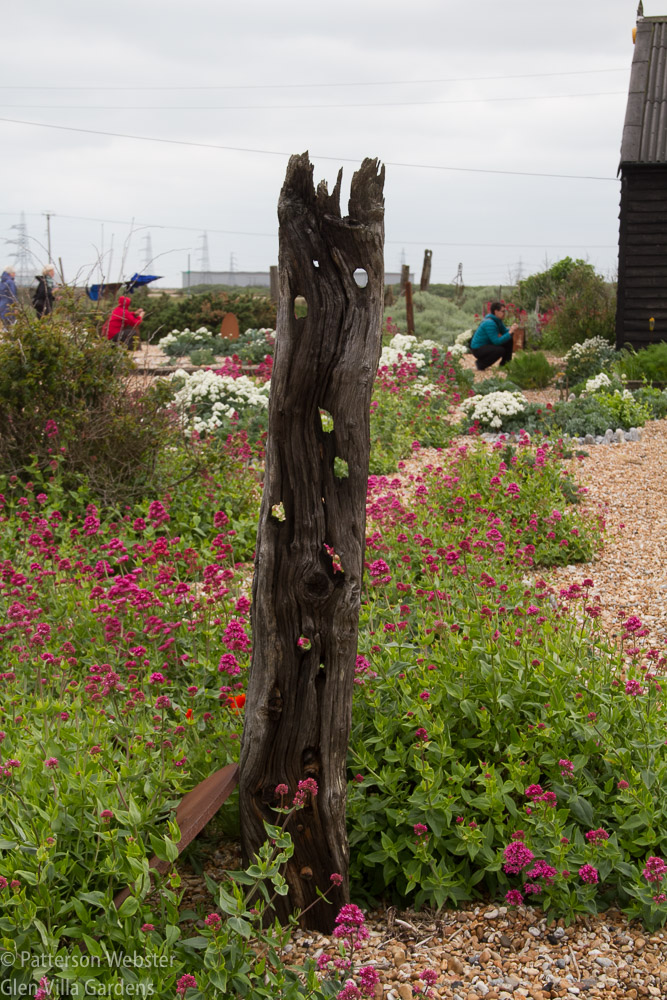
Some plants like these centranthus rubra thrive in difficult conditions.
Weathered posts originally installed to mark plants that died back in winter now mark the space like ancient standing stones. There are no fences, no boundaries of any sort, nothing to mark the garden off from the landscape around it. And more than any garden I’ve ever seen, this one seemed to continue endlessly, to the distant horizon and beyond.
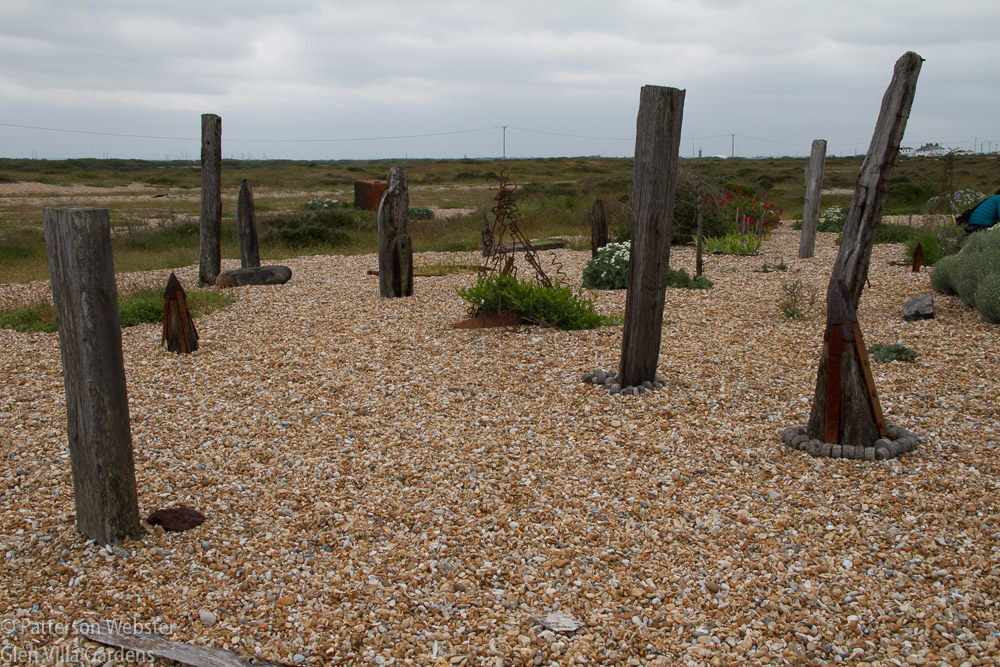
Positioned as they are, the posts suggested a processional path to the sea.
Without the conventions of fences or borders, the garden became part of the landscape, and the wildness around it became part of the garden. Excerpts from The Sun Rising, a poem by John Donne, reinforced this message, both through the words chosen and the way they were presented, black letters almost indistinguishable from the cottage’s black timber wall.
Busy old fool, unruly Sun,
Why dost thou thus,
Through windows, and through curtains, call on us ?
Must to thy motions lovers’ seasons run ?
Saucy pedantic wretch, go chide
Late school-boys and sour prentices,
Go tell court-huntsmen that the king will ride,
Call country ants to harvest offices ;
Love, all alike, no season knows nor clime,
Nor hours, days, months, which are the rags of time.
In that the world’s contracted thus ;
Thine age asks ease, and since thy duties be
To warm the world, that’s done in warming us.
Shine here to us, and thou art everywhere ;
This bed thy center is, these walls thy sphere.
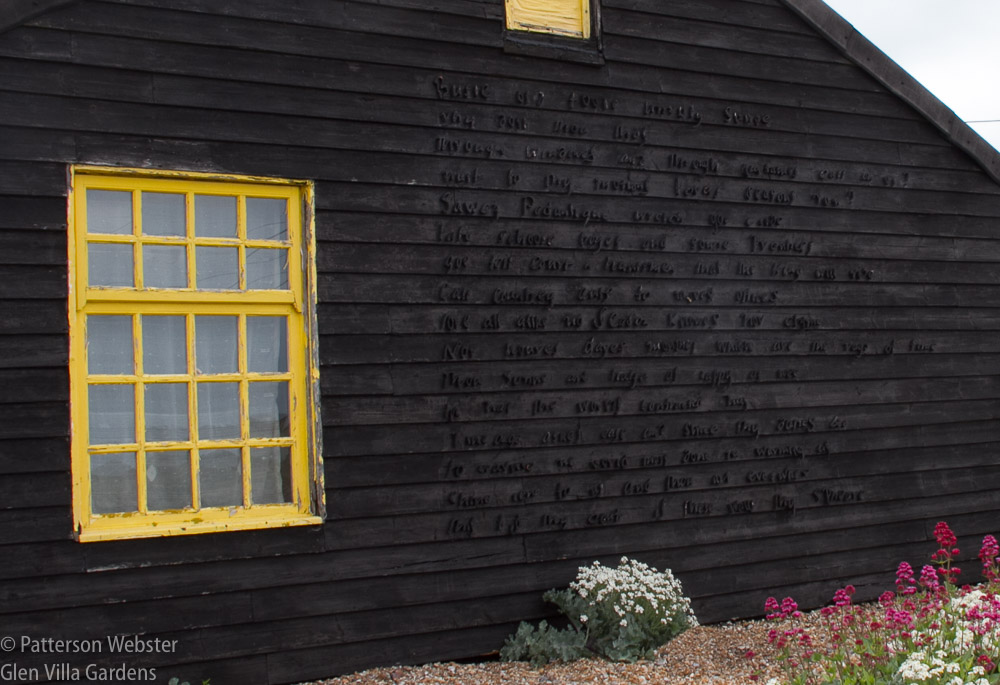
is it easier to read these words when the sun is at a different angle? I’d love to know.
I’ve thought a lot about this garden and how improbable it is, that in such a bleak setting a collection of ordinary objects can create such haunting beauty. For the last year I’ve been working on a new installation in the woods at North Hatley, and through the months since I visited it, Prospect Cottage has served as a point of reference, reminding me to add objects sparingly and to treat found objects with a care approaching reverence.
Those who saw the garden when Jarmon was alive say it is only a ghost of itself. That may be true, but if so, the ghost, while enigmatic and intensely personal, still speaks, very much alive.
Prospect Cottage itself is not open to the public. The garden is not open to the public either, but nor is it closed. Instead, visitors are free to wander. I recommend that you do.






Great post, this! Telling photos and gentle insight. A garden I would love to visit. Thanks, Pat.
This was an intriguing garden and writing about it so many months later brought it back vividly. I’d happily visit it again.
This is a haunting evocation of a ghost of a garden, Pat, with great photos. Never heard of this garden before, but it seems to reflect so much of what Jarman was about. Would love to see it – especially through your eyes. Thanks for this!
I’d like to visit it again, with you if that was possible. So glad you enjoyed the post.
The trials and tribulations of a garden let’s the mind have its way with you. Rubbish you say or translations from time passed; just wonderful!
It’s a place that sticks in the mind, Robert, that continues to intrigue me.
Lovely piece, Pat.
Simon
Thank you, Simon.
A fine presentation of this unusual garden. I think I would need to see it myself to make up my mind about it.
It provoked a lot of discussion among our group. Some people really loved it, others spent a few minutes walking around and went back to the bus.
I’ve read about this garden (I believe it is used as an example in Rainer and West’s Planting in a Post-Wild World). Both your images and your discussion make we want to visit.
If you have the chance to visit, it is well worth it.